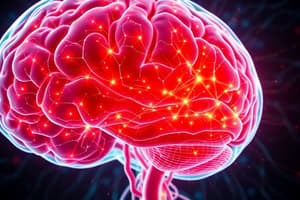Podcast
Questions and Answers
What primary function do large nerve fibers (Aβ) have in pain perception according to the gate control theory?
What primary function do large nerve fibers (Aβ) have in pain perception according to the gate control theory?
- They enhance the perception of pain by facilitating small nerve fibers.
- They activate inhibitory interneurons to modulate pain signals. (correct)
- They travel through the spinal cord to relay sensory information only.
- They transmit noxious pain signals directly to the brain.
According to the gate control theory, what happens when nonnoxious sensory input is present?
According to the gate control theory, what happens when nonnoxious sensory input is present?
- It entirely blocks all pain sensations from being transmitted.
- It suppresses pain by 'closing the gate' to noxious input. (correct)
- It amplifies the pain signals sent by the small nerve fibers (C).
- It increases the perception of pain due to distraction.
What are the two types of fibers involved in the balance of pain perception as per the gate control theory?
What are the two types of fibers involved in the balance of pain perception as per the gate control theory?
- Aα and Aδ fibers
- Aβ and B fibers
- C and D fibers
- Aβ and C fibers (correct)
Which of the following best explains a practical application of the gate control theory in pain management?
Which of the following best explains a practical application of the gate control theory in pain management?
How does the gate control theory suggest pain transmission can be modulated?
How does the gate control theory suggest pain transmission can be modulated?
Flashcards
Gate Control Theory
Gate Control Theory
Pain perception is influenced by the balance of information from large and small nerve fibers.
Large Nerve Fibers (Aβ)
Large Nerve Fibers (Aβ)
Sensory fibers that carry non-painful information.
Small Nerve Fibers (C)
Small Nerve Fibers (C)
Sensory fibers that carry pain signals.
Inhibitory Interneurons
Inhibitory Interneurons
Signup and view all the flashcards
Non-noxious Input
Non-noxious Input
Signup and view all the flashcards
Study Notes
Gate Control Theory
- Proposed by Wall and Melzack (1965)
- Explains pain perception as a balance between large and small nerve fibers
- Large nerve fibres (Aβ) carry information
- Small nerve fibers (C) carry information
- Collaterals of large sensory fibers (Aβ) activate inhibitory interneurons
- Inhibitory interneurons modulate pain transmission through small fibers (C)
- Non-noxious sensory input suppresses pain transmission
- Rubbing or liniments reduce pain by increasing non-noxious sensory input, thus closing the "gate" to noxious input.
Studying That Suits You
Use AI to generate personalized quizzes and flashcards to suit your learning preferences.




